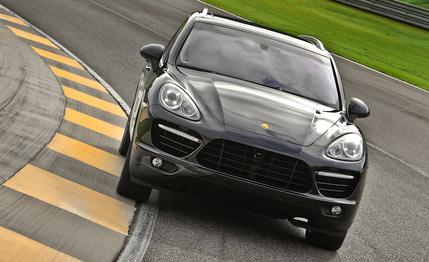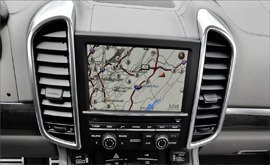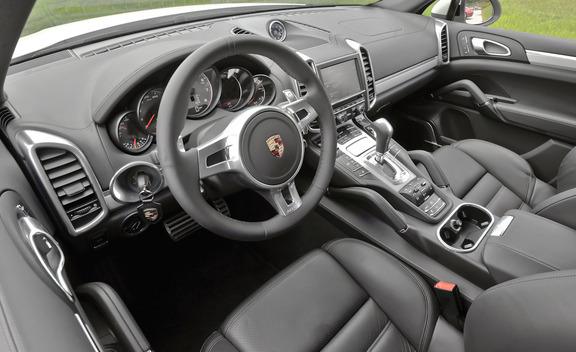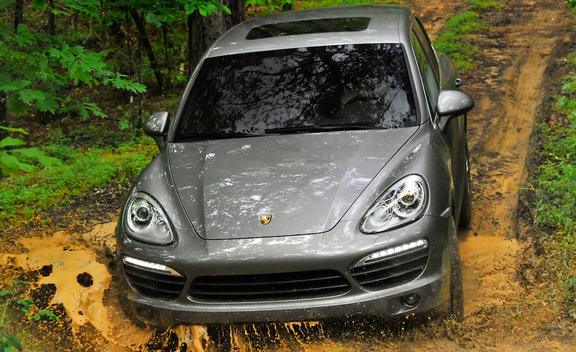 First Drive Review
First Drive Review
Longtime Porsche fans were largely appalled when the company introduced the Cayenne in 2003. How could a company that used to manufacture 911 lug nuts out of aluminum to save a few grams introduce an SUV whose weight—in some versions—approached 6000 pounds even though it could barely hold five adults?
Despite the disapproval of many Porschephiles, as well as most Car and Driver staffers, the Cayenne turned out to be a big success, selling more than 280,000 copies worldwide since its introduction and nearly 90,000 in the U.S. Porsche executives like to say that profits from the Cayenne have made possible the increasingly swift and sophisticated 911 models that have been introduced with some frequency over the past few years.

Bigger but Lighter
But with this second-generation Cayenne, Porsche has taken to heart many of the criticisms of the previous model. Most important, the company has taken about 400 pounds out of the Cayenne. About 70 pounds of that come from the elimination of the two-speed transfer case. Instead, the new model gets an eight-speed automatic with a lower first-gear ratio and more sophisticated traction control. About 65 pounds were found in other engine and powertrain reductions. Greater use of aluminum in the chassis yielded 72 pounds, lighter wheels and tires shaved 17 more, an electric parking brake dropped 13, and structural efficiencies eliminated 42 pounds.
A huge chunk of weight came out of the body, too, with 86 pounds eliminated through redesigned doors, 42 from a lighter interior, 22 from different electrical components, and 17 from various body-shell changes and other structural-attachment efficiencies. Despite these weight reductions, overall structural stiffness was increased by 15 percent, says Porsche.
Those agile at mental arithmetic will have noticed that these reductions add up to somewhat more than the claimed weight reduction. The difference between that figure and the actual reduction is additional content and reinforcement that had to be added in order to meet various legal requirements. Reducing a vehicle’s weight while adding content is quite an achievement.
Porsche engineers also managed to grow the Cayenne slightly in the process. The wheelbase is 1.6 inches longer, and the body has been lengthened by 1.9 inches. Combined with a rear seat that has an adjustable seatback angle and moves fore-and-aft over a range of 6.3 inches, there’s now plenty of room for four six-footers in the Cayenne. Cargo space is about the same as before.
Contrary to its slight size increase, the new model looks slightly smaller and tidier than its predecessor. It retains the main Porsche cues—front fenders slightly higher than the hood, which is rounded in the front; air intakes rather than any kind of radiator-like shell; and pronounced rear shoulders—but the body panels are smoother and neater than before. Despite the sleeker look, the drag coefficient is essentially unchanged at about 0.36.
So, So, So Much Better Inside
Inside, the improvement is overwhelming. The center console mimics the beautiful Panamera design with a neat array of buttons on an upward sloping panel. A new instrument cluster with a central tachometer and a customizable 4.8-inch TFT screen to its right provides all the primary information you need. In the usual Porsche fashion, the interior can be upgraded with leather swaddling just about everything, an Alcantara headliner, and five different trim options—you can check options boxes until you’re broke. After spending several hours in the new model, we think the old Cayenne looks plain and pedestrian inside.
Under the hood, the engines are largely carry-over, with the twin-turbo V-8 at the top of the line and the 3.6-liter, VW-derived V-6 at the bottom. But several powertrain upgrades serve to dramatically improve fuel economy. The most important is the switch from a six-speed to an eight-speed transmission. What this does is increase the spread of ratios between low gear and top gear from about 6:1 to 7.2:1. That means a lower first gear to help compensate for the loss of the dual-range transfer case, combined with a taller top gear for better fuel economy on the highway.

Interestingly, Porsche didn’t use its twin-clutch transmission—PDK in Porsche speak—on the Cayenne because the vehicle is so heavy and has substantial towing capacity. The company told us the clutches on the PDK would have a hard time with a combined load north of 9000 pounds. Porsche also says—and we can believe—the torque-converter automatic provides greater sensitivity and control in delicate off-road driving.
Further fuel-economy improvements come from the addition of automatic stop/start, which turns off the engine when you’re stopped. Then there are redesigned cooling systems to provide shorter warm-up times, optimized engine calibrations, smart charging to engage the generator during deceleration as much as possible, and tires with 10-percent-lower rolling resistance. Combined with the weight reduction, these changes result in a substantial 20-to-23-percent improvement in fuel economy based on European test figures.
New Hybrid Model
There’s also the addition of the new hybrid model, badged “Cayenne S Hybrid.” It has a different gasoline engine than any of the other models—the supercharged 333-hp, 3.0-liter V-6, borrowed from the Audi S4. A 47-hp electric motor/generator shaped like a six-inch-thick, 12-inch-diameter disk is sandwiched between this engine and the eight-speed automatic gearbox. A small 288-volt nickel-metal hydride battery pack sits under the luggage compartment along with the electronics to control the flow of power from the battery to the motor/generator and back.
One additional twist to this hybrid is a clutch placed between the engine’s flywheel and the electric motor. With this the engine can be completely disengaged from the rest of the drivetrain, which increases the electricity from regenerative braking and further improves fuel economy. It also lets the car coast effortlessly without the drag of engine braking. Porsche (and VW, whose new Touareg hybrid has the same powertrain) calls this mode “sailing,” and it is enabled up to a speed of 97 mph.
The combined output of the gasoline and electric motors is 380 hp and 427 lb-ft of torque, which is a little less power but more torque than the V-8 Cayenne S generates. However, the necessary hardware adds nearly 400 pounds to the hybrid compared with the V-8, making this model even heavier than the Turbo. Still, acceleration to 60 mph is claimed to be only half a second slower than the V-8’s (6.1 versus 5.6 seconds) and more than a second better than the six-cylinder model’s (7.4 seconds with the automatic). Fuel efficiency—on the European tests—is the best in the range, says Porsche, about 17 percent better than the V-6’s and 22 percent better than the V-8’s.
Driving the New Generation
We had an opportunity to drive all but the V-6–powered entry-level Cayenne, which will be introduced a bit later. Our drive was at Barber Motorsports Park, so we took the cars onto the track for some hot laps. Few manufacturers would introduce their SUVs at a racetrack, but the big Cayennes are very comfortable in such an environment, diving toward apexes and rocketing out of corners.
As you’d expect, the Turbo, with its beefy 265/50-19 tires, firm suspension, and 500 hp felt not only the quickest but also the easiest to drive on the track. Body motions were well controlled, the machine was always planted, and there was plenty of grip at any speed. Porsche claims a top speed of 172 mph and 0-to-60 acceleration of 4.4 seconds for the Turbo, and the Porsche Sport Driving School instructors on hand said the Cayenne Turbo laps the Barber circuit quicker than a base 911 Carrera.
The Cayenne S was almost as satisfying, even though its suspension wasn’t quite as buttoned down. Carving smooth arcs through the track’s 17 corners was easy and—if we’re honest—pretty fun, particularly on the model fitted with the optional Porsche Torque Vectoring Plus system. This system was introduced last year on the new 911 Turbo, and it basically uses the vehicle’s rear brakes to send more torque to the outside rear wheel when turning into a corner. The difference is quite noticeable. The Cayenne fitted with this system turned in as if it had shed 1000 pounds.
Although not conceived for any sort of track use, the Cayenne S hybrid performed competently at Barber, but it required a more delicate touch. With a softer suspension calibration and lighter steering, the hybrid needed to be driven with greater smoothness as we started going quickly. It was imperative to select the sport mode for the powertrain to prevent the engine from shutting off when braking into a corner. When it shut off, there was a slight but irritating delay when we picked up the power at the apex. Of course, only the journalists on this press trip would ever be likely to experience this situation, so it’s an extremely minor quibble.

The Barber facility has a challenging off-road area where we played a bit with the Cayenne Turbo. Despite the loss of the two-speed transfer case, the new model displayed plenty of traction and thrust, even on the steepest and most slippery sections. Part of this capability comes from the lower first gear in the new transmission and part comes from changes in the Porsche Traction Management system that now works with a computer-controlled multiplate clutch in the center differential that can distribute the torque fore-and-aft as needed.
Combined with Porsche’s version of hill-descent control and the air suspension’s ability to raise the ground clearance, the Cayenne Turbo negotiated this severe course with ease. The only downside was a lack of forward visibility when the grades changed rapidly. With the Cayenne’s high nose and the machine jacked up, we couldn’t see what was directly in front, especially when cresting a grade. You would be well advised to get out and check your path during rigorous off-road drives, all five of you future owners who will attempt such a thing.
On the road, the 2011 Cayenne is a wonderfully comfortable and luxurious buggy. Every version is smooth, quiet, and refined. The eight-speed transmission shifts frequently, constantly selecting the optimal ratio for ever-changing driving circumstances—and you can follow its efforts because there’s a gear display on the Cayenne’s dashboard. But the shifts are remarkably smooth; you’d never notice the gearchanges if you didn’t notice the digits on the display. With this new-generation Cayenne, there’s a more noticeable difference among the suspension adjustments, although even in the sportiest setting, the ride was reasonable on the pristine Alabama roads near the track.
Interestingly, the hybrid model doesn’t seem to employ the electric motor much during everyday driving. You need to apply full throttle before the motor kicks in to boost the performance, or you can press the E-power button on the center console, which forces the electric motor to cut in a bit sooner.
Porsche has done an excellent job of minimizing the transition between regenerative and hydraulic braking on the Cayenne hybrid. However, if you try to apply the brakes gently, you can’t, because the regenerative braking has a minimum threshold level. At the other end, there’s a tiny delay when you release the brakes. Perhaps these niggles wouldn’t matter if you drove the hybrid every day.
The 2011 Cayenne S and Turbo go on sale in early July; the base Cayenne and the S hybrid follow in the fall. Base prices range from $47,675 to $105,775, but as usual with Porsches, your susceptibility to options will have a huge effect on the final cost. Porsches are never cheap, and these Cayennes are no exception, but the vehicles do deliver a remarkable degree of versatility. Although a Range Rover would be every bit as capable—or more—as a Cayenne Turbo off-road, it couldn’t touch the Turbo’s aplomb on a winding road or racetrack. And it likely would suck more fuel in either context.
For those who want a do-anything machine that is comfortable, luxurious, and practical, these updated Porsche Cayennes have much to offer. And although it’s still difficult for some of us to accept a Porsche SUV, this second-generation Cayenne is much truer to Porsche’s efficiency ethic than was the original.